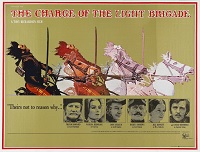
The Battle of the Alma took place during the Crimean War between an allied expeditionary force and Russian forces defending the Crimean Peninsula on 20 September 1854. The allies had made a surprise landing in Crimea on 14 September. The allied commanders, Maréchal Jacques Leroy de Saint-Arnaud and Lord Raglan, then marched toward the strategically important port city of Sevastopol, 45 km (28 mi) away. Russian commander Prince Alexander Sergeyevich Menshikov rushed his available forces to the last natural defensive position before the city, the Alma Heights, south of the Alma River.
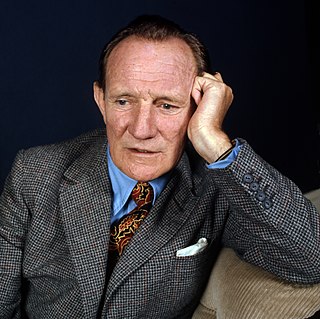
Trevor Wallace Howard-Smith was an English stage, film, and television actor. After varied work in the theatre, he achieved star status with his role in the film Brief Encounter (1945), followed by The Third Man (1949).

Field Marshal FitzRoy James Henry Somerset, 1st Baron Raglan,, known before 1852 as Lord FitzRoy Somerset, was a British Army officer. When a junior officer, he served in the Peninsular War and the Waterloo campaign, latterly as military secretary to the Duke of Wellington. He also took part in politics as Tory Member of Parliament for Truro, before becoming Master-General of the Ordnance.
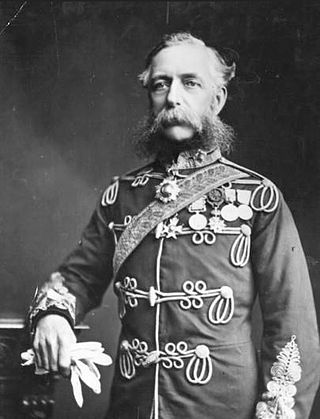
Lieutenant-General James Thomas Brudenell, 7th Earl of Cardigan,, styled as Lord Cardigan, was an officer in the British Army who commanded the Light Brigade during the Crimean War, leading its charge at the Battle of Balaclava.

The Battle of Balaclava, fought on 25 October 1854 during the Crimean War, was part of the Siege of Sevastopol (1854–55), an Allied attempt to capture the port and fortress of Sevastopol, Russia's principal naval base on the Black Sea. The engagement followed the earlier Allied victory in September at the Battle of the Alma, where the Russian General Menshikov had positioned his army in an attempt to stop the Allies progressing south towards their strategic goal. Alma was the first major encounter fought in the Crimean Peninsula since the Allied landings at Kalamita Bay on 14 September, and was a clear battlefield success; but a tardy pursuit by the Allies failed to gain a decisive victory, allowing the Russians to regroup, recover and prepare their defence.

George Charles Bingham, 3rd Earl of Lucan,, styled Lord Bingham before 1839, was an Anglo-Irish aristocrat and British Army officer. He was one of three men, along with Captain Nolan and Lord Raglan, responsible for the fateful order during the Battle of Balaclava in October 1854 that led to the Light Brigade commander, the Earl of Cardigan, leading the Charge of the Light Brigade. He was subsequently promoted to field marshal.

The Royal Regiment of Horse Guards (The Blues) (RHG) was a cavalry regiment of the British Army, part of the Household Cavalry.
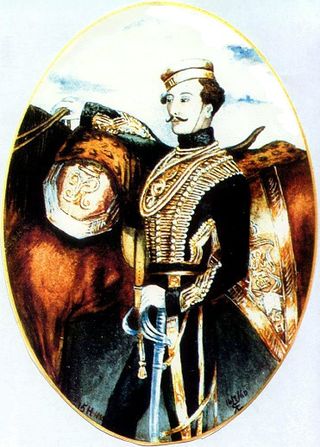
Lewis Edward Nolan, known to his family as Louis Nolan and in Austrian service as Ludwig Nolan was a British Army officer and cavalry tactician best known for his role and death in the Charge of the Light Brigade during the Crimean War. Born to a infantry officer and minor official and his wife, Nolan was educated at the Austrian Inhaber Pioneer School at Tulln, where he was noted as an enthusiastic horseman and military theorist. After early graduation he was commissioned as a subaltern in the 10th Austrian Hussar regiment, serving in Austria, Hungary and on the Polish frontier, where he again became known for his horsemanship and was promoted to senior lieutenant. Due to the nepotism in the Austro-Hungarian armed forces, Nolan transferred to the British Army as a cornet in the 15th Light Dragoons.
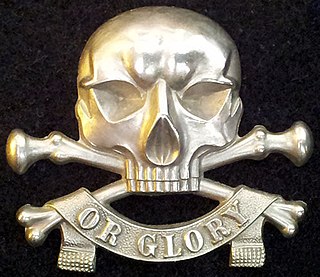
The 17th Lancers (Duke of Cambridge's Own) was a cavalry regiment of the British Army, raised in 1759 and notable for its participation in the Charge of the Light Brigade during the Crimean War. The regiment was amalgamated with the 21st Lancers to form the 17th/21st Lancers in 1922.

Charles Wooden VC was a German-born soldier in the British Army and a recipient of the Victoria Cross, the highest award for gallantry in the face of the enemy that can be awarded to British and Commonwealth forces.

Samuel Parkes VC was an English recipient of the Victoria Cross, the highest and most prestigious award for gallantry in the face of the enemy that can be awarded to British and Commonwealth forces. Parkes was awarded his VC for his actions during the Charge of the Light Brigade.

General Sir James Yorke Scarlett was a British Army officer and hero of the Crimean War who led the Charge of the Heavy Brigade during the Battle of Balaclava on 25 October 1854.

Flashman at the Charge is a 1973 novel by George MacDonald Fraser. It is the fourth of the Flashman novels. Playboy magazine serialised Flashman at the Charge in 1973 in their April, May and June issues. The serialisation is unabridged, including most of the notes and appendixes and features a few illustrations, collages from various paintings and pictures to depict a period montage of the Charge and Crimea.

The Charge of the Light Brigade is a 1936 American historical adventure film from Warner Bros., starring Errol Flynn and Olivia de Havilland. It was directed by Michael Curtiz and produced by Samuel Bischoff, with Hal B. Wallis as the executive producer. The film's screenplay is by Michael Jacoby and Rowland Leigh, from a story by Michael Jacoby, and based on the 1854 poem "The Charge of the Light Brigade" by Alfred, Lord Tennyson. The music score was composed by Max Steiner, his first for Warner Bros., and the cinematography was by Sol Polito. Scenes were shot at the following California locations: Lone Pine, Sherwood Lake, Lasky Mesa, Chatsworth, and Sonora. The Sierra Nevada mountains were used for the Khyber Pass scenes.

Frances Isabella Duberly was an English soldier’s wife who wrote a journal of her experiences on campaign in the Crimean War and the Indian Rebellion of 1857 which was afterwards published. Her husband, Captain Henry Duberly, was paymaster to the 8th Royal Irish Hussars, part of the British light cavalry that took part in the Charge of the Light Brigade. Duberly's journal of her time in Crimea was published as Journal Kept During the Russian War (1856). It not only includes eye-witness accounts, but is also a record of gossip and rumours circulating in the British Army.

The Charge of the Light Brigade was a military action undertaken by British light cavalry against Russian forces during the Battle of Balaclava in the Crimean War, resulting in many casualties to the cavalry. On 25 October 1854, the Light Brigade, led by Lord Cardigan, mounted a frontal assault against a Russian artillery battery which was well prepared with excellent fields of defensive fire. The charge was the result of a misunderstood order from the commander in chief, Lord Raglan, who had intended the Light Brigade to attack a different objective for which light cavalry was better suited, to prevent the Russians from removing captured guns from overrun Turkish positions. The Light Brigade made its charge under withering direct fire and reached its target, scattering some of the gunners, but was forced to retreat immediately.
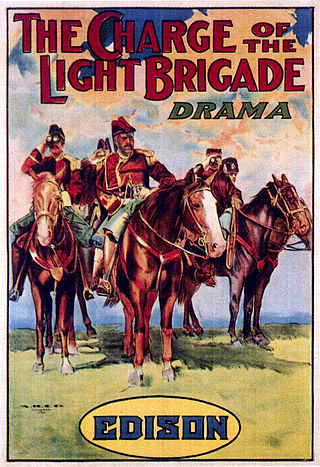
The Charge of the Light Brigade is a 1912 American silent historical drama film directed by J. Searle Dawley. Produced by Edison Studios, the film portrays the disastrous yet inspiring military attack in October 1854 by British light cavalry against Russian artillery positions in the Battle of Balaclava during the Crimean War. Director Dawley also wrote the scenario for this production, adapting it in part from the famous 1854 narrative poem about the charge by British poet laureate Alfred, Lord Tennyson, who completed his poem just six weeks after the actual event. The film's action scenes and landscape footage were shot between late August and early September 1912, while Dawley and his company of players and crew were on location in Cheyenne, Wyoming. In order to produce a sizable and believable recreation of the charge, the director needed a very large number of horsemen. Fortunately for Dawley, the commander of United States Army cavalry at Fort D. A. Russell at Cheyenne agreed to provide "about 800" troopers and "their trained mounts" to the Edison project.

Balaclava is a 1928 British silent and sound war film directed by Maurice Elvey and Milton Rosmer and starring Cyril McLaglen, Benita Hume, Alf Goddard, Harold Huth, and Wally Patch. It was made by Gainsborough Pictures with David Lean working as a production assistant. The charge sequences were filmed on the Long Valley in Aldershot in Hampshire. Although the sound version had no audible dialogue, it featured a synchronized musical score with sound effects. The sound version was released in the United States under the title Jaws Of Hell.
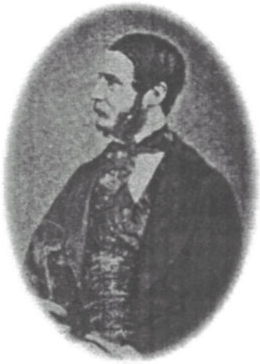
Lieutenant-Colonel William Morris was a British Army officer who rode in the Charge of the Light Brigade.

Somerset John Gough-Calthorpe, 7th Baron Calthorpe,, was a British soldier and politician.
